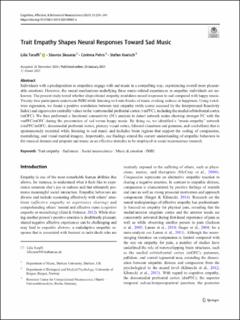| dc.contributor.author | Taruffi, Liila | |
| dc.contributor.author | Skouras, Stavros | |
| dc.contributor.author | Pehrs, Corinna | |
| dc.contributor.author | Koelsch, Stefan | |
| dc.date.accessioned | 2022-04-04T07:57:57Z | |
| dc.date.available | 2022-04-04T07:57:57Z | |
| dc.date.created | 2021-05-17T13:57:28Z | |
| dc.date.issued | 2021 | |
| dc.identifier.issn | 1530-7026 | |
| dc.identifier.uri | https://hdl.handle.net/11250/2989420 | |
| dc.description.abstract | Individuals with a predisposition to empathize engage with sad music in a compelling way, experiencing overall more pleasurable emotions. However, the neural mechanisms underlying these music-related experiences in empathic individuals are unknown. The present study tested whether dispositional empathy modulates neural responses to sad compared with happy music. Twenty-four participants underwent fMRI while listening to 4-min blocks of music evoking sadness or happiness. Using voxel-wise regression, we found a positive correlation between trait empathy (with scores assessed by the Interpersonal Reactivity Index) and eigenvector centrality values in the ventromedial prefrontal cortex (vmPFC), including the medial orbitofrontal cortex (mOFC). We then performed a functional connectivity (FC) analysis to detect network nodes showing stronger FC with the vmPFC/mOFC during the presentation of sad versus happy music. By doing so, we identified a “music-empathy” network (vmPFC/mOFC, dorsomedial prefrontal cortex, primary visual cortex, bilateral claustrum and putamen, and cerebellum) that is spontaneously recruited while listening to sad music and includes brain regions that support the coding of compassion, mentalizing, and visual mental imagery. Importantly, our findings extend the current understanding of empathic behaviors to the musical domain and pinpoint sad music as an effective stimulus to be employed in social neuroscience research. | en_US |
| dc.language.iso | eng | en_US |
| dc.publisher | Springer | en_US |
| dc.rights | Navngivelse 4.0 Internasjonal | * |
| dc.rights.uri | http://creativecommons.org/licenses/by/4.0/deed.no | * |
| dc.title | Trait Empathy Shapes Neural Responses Toward Sad Music | en_US |
| dc.type | Journal article | en_US |
| dc.type | Peer reviewed | en_US |
| dc.description.version | publishedVersion | en_US |
| dc.rights.holder | Copyright Crown 2021 | en_US |
| cristin.ispublished | true | |
| cristin.fulltext | original | |
| cristin.qualitycode | 2 | |
| dc.identifier.doi | 10.3758/s13415-020-00861-x | |
| dc.identifier.cristin | 1910313 | |
| dc.source.journal | Cognitive, Affective, & Behavioral Neuroscience | en_US |
| dc.source.pagenumber | 231-241 | en_US |
| dc.identifier.citation | Cognitive, Affective, & Behavioral Neuroscience. 2021, 21 (1), 231-241. | en_US |
| dc.source.volume | 21 | en_US |
| dc.source.issue | 1 | en_US |

